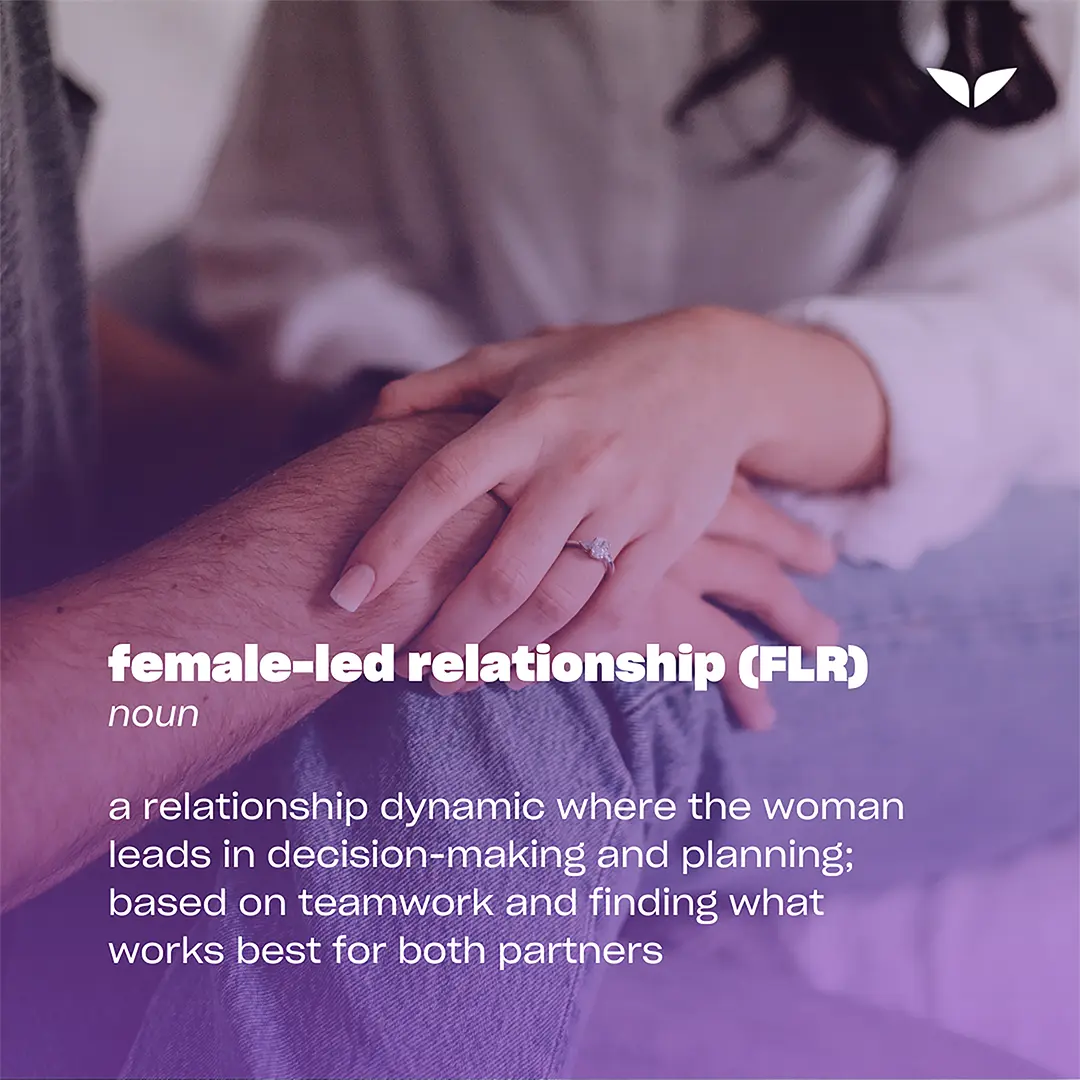Many of us grew up with that fairytale rom-com stuff: the damsel in distress and the knight in shining armor coming in to save the day, and they both ride off into “happily ever after.”
No more. Now, the world of love has transitioned to where women can take the lead in ways that redefine what partnership means.
Think Monica and Chandler from Friends. Jessica Huang from Fresh Off the Boat. Or, if you prefer a more IRL example, the late Queen Elizabeth and Prince Phillip.
They embody the very essence of the female-led relationship (FLR), meaning building connection, trust, and balance in a way that feels real. It’s a dynamic that invites you to rethink how your own relationship can come together.
As Neelam Verma, the founder of Integrity Dating and trainer of Mindvalley’s Finding Love with Integrity Dating program, says, “Dating and relationships could be a place of growth where you’re elevating each other, growing with each other, transforming with each other.”
And when women lead with intention, love becomes a whole new kind of powerful.
What does FLR (female-led relationship) mean?
At its core, the “FLR” meaning points to the balance between you and your partner. It’s a conscious choice to move away from traditional roles and create something that feels equal, alive, and intentional.
The term “FLR” first appeared in the BDSM and kink communities. Yet, today, it describes a much wider truth: a relationship where you take the lead in certain areas of decision-making and direction.
Just because it’s “female-led” doesn’t mean you’re hungry for control and domination. Rather, it’s a partnership built on conscious mutual agreement.
You might manage finances, set goals, plan your daily life, or take on roles previously considered “only male.” And you’ll do them in ways that feel right for both you and your partner.
“The key is that the man consciously agrees to be led by the woman in her areas of leadership and gives her the authority and power to do so,” Andreea Tamas, a conscious relationship expert, tells Mindvalley.
Because of that, there’s respect, there’s value, and there’s integrity in how you both want your relationship to function. In fact, research shows that people who mix masculine traits like independence with feminine ones like empathy tend to feel happier and healthier.
When done right, it becomes a space where both of you can grow, connect, and truly align.

FLR vs. traditional relationships
Every relationship has its rhythm. Here’s how FLRs and traditional approaches differ:
| Aspect | Traditional relationship | Female-led relationship (FLR) |
| Leadership | Man leads most areas. | Woman leads agreed areas with emotional intelligence and clarity. |
| Equality | Roles follow convention. | Roles defined by choice and mutual respect. |
| Communication | Needs often go unspoken. | Open, honest, and revisited regularly. |
| Power dynamic | One partner holds more control. | Power shared through trust and consent. |
| Decision-making | Logic and structure drive choices. | Intuition and collaboration guide direction. |
| Emotional connection | Based on duty or routine. | Built on vulnerability and balance. |
In many modern relationships, people are torn between old and new ideas about how love “should” work.
“I believe so many people misunderstand FLR first because there is no education around it, and there is still a lot of shame in the men’s world around having a woman be the ‘leader,’” says Andreea.
But there’s no right or wrong here. It’s really a matter of preference.
So if you’re opting for an FLR, Andreea points out that it truly works when the man trusts the woman’s “ability and loves this different dynamic from the traditional one.” And that kind of agreement turns power into partnership and leadership into love.
The 4 main types of female-led relationships
FLRs come in many shapes and sizes. But one of the best things about FLRs is its flexibility.
You and your partner aren’t bound to a single type of dynamic. Instead, you can mix and match these elements depending on your strengths and what works best for the both of you.
Maybe one leads in emotional growth while the other takes charge of finances, or perhaps both take on different aspects of leadership, creating a hybrid dynamic that suits their unique needs.
When a woman leads with her feminine energy, she leads from her heart and intuition rather than control.
— Andreea Tamas, conscious relationship expert
Here are some of the most common FLRs you’ll find out there:
Financial FLR
You take charge of the financial aspects—budgeting, managing expenses, making investment choices, and setting long-term financial goals. Kind of like what Beth Pearson from This Is Us does for her family.
This type of FLR can help relieve stress for you and your partner, ensuring the family’s financial health is in good hands. It can also promote better decision-making since you’re taking the lead in planning and strategizing for the future.
Domestic FLR
This has Emily Gilmore written all over it. The matriarch from Gilmore Girls oversees everything from organizing the household to making sure that chores and family events run smoothly.
This dynamic allows both you and your partner to focus on your individual goals. With a clear structure at home, everything runs smoothly and with less stress.
Emotional FLR
You know how to start a conversation that’s deep and meaningful. And you often help guide you and your partner through conflicts by encouraging open communication and empathy.
This FLR creates a space where you can both express vulnerability, process emotions with care, and build a deeper, more secure bond.
Just look at Michelle Obama. Sure, she’s not a character on a television show, but she portrays that warmth and wisdom while leading with emotional intelligence.
Complete FLR
You’re essentially a Miranda Bailey from Grey’s Anatomy. You lead in most aspects of the relationship—finances, household management, emotional growth, and even making big life decisions.
While your man supports your vision, this type of relationship relies on a deep sense of trust and respect.
FLR levels explained (low to complete)
“When a woman leads with her feminine energy,” Andreea points out, “she leads from her heart and intuition rather than control.”
And how this dynamic plays out can vary widely, depending on how much leadership the woman wants to take on and what works for both partners.
| Level | What it looks like | How it feels |
| Light FLR | You lead in small moments—dates, plans, emotional tone. | Natural and playful, a gentle flow of leadership that enhances connection. |
| Moderate FLR | You take charge of key areas like goals, finances, or home life. | You both communicate often to stay balanced and aligned. |
| Strong FLR | You guide most decisions with intention and clarity. | Your partner trusts your vision and feels secure in your guidance. |
| Complete FLR | You lead fully emotionally, financially, and practically. | It takes deep mutual respect and communication to keep it thriving. |
Benefits and challenges of an FLR
Like any relationship dynamic, FLRs come with their own set of benefits and challenges. Understanding these can help you decide if this approach is right for you and your partner.
Benefits
1. Clear roles and responsibilities
When you and your partner each know your role, decision-making becomes smoother and less stressful. It creates structure while leaving space for flexibility and collaboration.
2. Encourages empowerment
Leading in love helps you both grow in confidence. You step into your strength, and he learns the value of trust and emotional maturity.
3. Breaks limiting traditional norms
FLRs challenge outdated gender expectations and open the door to more balanced, conscious partnerships.
4. Balances strengths
Each one of you brings out your best qualities to the table. You lead with your women’s intuition and clarity, while your partner supports with stability and trust.
5. Promotes trust and collaboration
Andreea points out that when you lead consciously, you bloom, and that energy inspires your partner to grow too. That mutual trust becomes the foundation of lasting harmony.
6. Creates a safe space for vulnerability
Both you and your partner can express emotions freely, knowing the relationship is rooted in respect, safety, and mutual care.
Challenges
1. Risk of imbalance
You might find yourself managing most of the decisions or emotional work, even when that wasn’t the plan. For instance, you end up handling finances, schedules, and emotional check-ins while your partner waits for direction.
2. Potential for resentment
When your partner doesn’t recognize your effort or when you feel unheard, quiet frustration can start to build. Maybe you plan everything from date nights to bills, and it feels like he’s just following along.
3. Social stigma
Friends or family may not understand your dynamic. You might hear comments like, “So you’re the boss now?” or see subtle judgment when you take the lead in public.
4. Leadership pressure
Leading every day can feel like you’re always “on.” For example, when both of you are stressed, you might still feel responsible for carrying the mental load and keeping things calm and organized.
5. Miscommunication about expectations
If you both assume the other knows what’s expected, misunderstandings can pile up. Maybe you think you’re leading in one area, while your partner assumes it’s still shared.

7 female-led relationship rules for a balanced partnership
The best FLRs flourish on strong foundations.
Dating and relationships could be a place of growth where you’re elevating each other, growing with each other, transforming with each other.
— Neelam Verma, trainer of Mindvalley’s Finding Love with Integrity Dating program
Inspired by Neelam’s transformative work in her Mindvalley program, these seven FLR rules help you lead with confidence, connection, and clarity. And in doing so, you create a partnership that truly shines.
1. Put self-love first
“When your foundation is rooted in self-love, you release the pressure of looking to someone to make you happy,” explains Neelam. In other words? You’re confident, clear, and certain about who you are and what you can bring to the table.
Research has shown that when you practice self-love, like taking care of yourself, accepting who you are, and giving yourself some real love, it’s closely tied to better mental health and well-being. These habits help build emotional strength and healthier relationships.
And when you make this a priority, the connection between you and your partner, as Neelam points out, “becomes a place where two souls are connecting, growing, and evolving together instead of completing each other.”
2. Lead with integrity
Integrity means leading from your values, not ego, fear, or control. “You honor your feelings, you listen to your inner voice, and you speak your truth,” Neelam says.
In an FLR, integrity builds respect. It creates a shared foundation of honesty and equality that strengthens connection.
When your actions align with your values, both of you feel safe to express needs and make decisions openly. That’s how real trust takes root.
3. Foster open communication through authenticity
“Conscious conversations lead to conscious relationships,” Neelam reminds us. And that means being seen and heard with honesty and without fear of judgment.
Being authentic gives that communication its depth. When you speak honestly about your needs, desires, and emotions, you invite your partner to do the same. It dissolves pretense and builds connection through clarity.
Healthy communication also sets natural boundaries. It keeps both of you aligned about who leads where and how decisions flow. And when those conversations happen with compassion, respect becomes the default language of your relationship.
4. Show vulnerability
Being vulnerable means leading with your heart, not just your head. Neelam explains that being in a relationship, even in a female-led one, “requires you to put your heart out there so you cannot only receive but give love.”
Sure, vulnerability often gets mistaken for weakness. However, being open is actually an act of courage because you’re sharing your true feelings, fears, and desires, even when it feels scary.
This, then, opens up the space for deeper trust and connection. And it encourages your partner to do the same, turning the relationship into a safe, supportive environment.
5. Respect each other’s boundaries
Respect is the quiet rhythm that keeps love steady. Boundaries act as signposts that help you stay connected while staying true to yourself.
In an FLR, boundaries maintain balance. They guide when to lead, when to listen, and when to pause, ensuring that you and your partner feel seen and supported.
When those limits fade, it becomes easy to fall into people-pleaser patterns that blur your needs and drain your energy. By honoring boundaries with awareness and care, you keep love grounded, balanced, and respectful.
6. Create emotional equality
Emotional equality is the space where both partners feel seen, supported, and fully human.
You might notice it in the smallest moments: when you’ve had a long day and your partner steps in to make dinner without being asked. Or when you pause mid-conversation to really listen instead of trying to fix it. Those gestures remind you that equality is something you practice together, again and again.
As Neelam teaches, energy moves freely when appreciation replaces assumption. When you lead from awareness, your guidance encourages strength in your partner and draws out the best in both of you.
7. Embrace the power of surrender
Surrender embodies the feminine energy. It’s about trust and letting love between you and your partner flow naturally. And, in an FLR, it allows you and your partner to relax into your roles without power struggles.
If you’re the female, this means letting go of micromanaging and trusting your partner to contribute meaningfully. For them, it’s about embracing the dynamic and trusting your guidance.
“Surrendering to your partner opens you up to real intimacy and love,” Neelam explains. “You surrender to the possibility of a greater union between you and someone else, and it becomes divine.”
FLR in modern dating: Shifting roles
Just like in long-term relationships, the FLR meaning in dating is about redefining traditional roles so that you can confidently take the lead.
Take Monica in Friends, for instance. She initiated the first kiss in London, declared their relationship to the group, and even started proposing to Chandler (before nudging him to make the big gesture himself).
When you lead with that same awareness, the dating dynamic shifts in a refreshing way. The reality is, traditional expectations often put pressure on men to take the lead in planning dates, starting meaningful conversations, and so on. That pressure can build emotional strain and add to the mental load even before the date begins.
By taking initiative, you create space for balance. You share the effort of planning, guiding the conversation, and setting intentions. This gives both of you a chance to align your values and goals early on.
Andreaa highlights that when you operate from this space, your partner actually feels inspired to give more. She explains, “She learns how to receive from her man, not because she needs it, but because it gives them both pleasure. The man loves to give to the divine feminine, but she has to be open, receptive, and appreciative of what the man provides and not take it for granted.”
And it doesn’t stop at dating. The same awareness continues when you build a life together. Research shows that when both partners share leadership and stay attuned to each other’s emotional needs, your relationship matures with less tension and greater respect.
Emotional intelligence is what makes this possible. It helps you navigate changing roles with empathy, self-awareness, and balance. When you lead from understanding instead of ego, your love stops feeling like a performance and starts feeling like presence.
Real-life and pop culture female-led relationship stories
We see FLRs play out in some of the most relatable stories around us—Monica and Chandler being a classic example. Here are a few others that show how love can take different shapes and still be extraordinary:
- Daphne and Simon (Bridgerton). Daphne leads the emotional growth in her marriage to Simon. She encourages him to confront his past, open up about his feelings, and work toward building a deeper and more authentic connection.
- Beth and Randall Pearson (This Is Us). They’re a great example of a couple that moves between different levels of FLR intensity. While Beth leads in many areas, from managing her career to making key family decisions and becoming the family’s primary breadwinner, there are times when she surrenders more and allows Randall to take the lead. Their dynamic shows that an FLR doesn’t have to be static—it can shift based on the needs of the relationship and the personal growth of both partners.
- Jessica and Louis Huang (Fresh Off the Boat). Jessica manages finances, organizes schedules, and makes critical decisions for her family, amongst other things. Louis embraces her leadership, often seeking her advice and working alongside her to ensure their family’s success.
- Queen Victoria and Prince Albert. As one of history’s most iconic couples, Queen Victoria ruled an empire while Prince Albert focused on family matters and supported her reign. Their relationship showcased mutual respect and collaboration, with Albert acting as her confidant and advisor.
- Michelle and Barack Obama. Michelle’s leadership shines in her partnership with Barack. From supporting his political career to grounding their family life, she plays a guiding role. Barack frequently credits her wisdom and influence as vital to his growth both personally and professionally.
These stories remind us that when women lead with intention (and have a supportive partner), love becomes a force that inspires, empowers, and transforms.
Frequently asked questions
What is the difference between an FLR and a femdom relationship?
An FLR is a lifestyle choice built on emotional awareness, communication, and mutual respect. A femdom relationship, on the other hand, is a sexual or role-play practice that centers on dominance and submission.
In an FLR, leadership extends into daily life, where the woman often guides direction, decision-making, or emotional connection. A femdom dynamic focuses more on erotic expression and consensual power play.
Both forms rely on trust and clear boundaries, yet they fulfill different needs within a relationship.
What are some misconceptions about female-led relationships?
Many believe a female-led relationship gives the woman total control or turns the man into a follower. In reality, it’s a conscious partnership based on respect, trust, and emotional balance.
According to Andreea, many misconceptions exist because there’s little education or open conversation about FLRs. Some men still feel social pressure or shame around the idea of a woman leading, which keeps the topic hidden.
“When we bring awareness, education, and conversation to it,” she adds, “we dissolve the misconception, and we begin to see that it’s not about power over, but power with.”
Is FLR healthy?
Yes, a female-led relationship can be deeply healthy when you build it on awareness, communication, and mutual respect. It gives both you and your partner the freedom to express your strengths without fear or tension.
As Andreea explains, a healthy FLR begins when you lead with your feminine energy, and you can do this through intuition, care, and emotional connection rather than control. You nurture yourself first, and that balance allows you to nurture your partner and the relationship with ease.
In that space, you both understand your roles, value each other’s contributions, and make decisions together. Mutual trust becomes the foundation. When your dynamic stays conscious and balanced, both of you feel empowered, respected, and emotionally fulfilled.
Love deeper, connect stronger
Forget the traditional rom-com knight in shining armor fairytale. This is your love story, and it’s yours to lead.
Understanding the FLR meaning can be the starting point to help you reshape your approach to love with clarity and intention. With Mindvalley, you’ll find free resources for relationships to help you grow in every stage of connection—from learning your love style to mastering emotional awareness.
- Need insight? Take the Love Styles Quiz and discover what drives your relationships.
- Craving deeper connection? Try self-love meditations that bring you back to your center.
- Curious about conscious love? Watch free classes like Calling in “The One” or The Science of Great Sex and explore intimacy through wisdom, not guesswork.
- Want real-life tools for communication? Download Conversation Starters and spark meaningful dialogue with your partner.
- Ready to expand your circle? Join webinars, like the Build Your Dream Community, and learn to nurture relationships that uplift and inspire you.
Every resource helps you build relationships rooted in respect, balance, and emotional intelligence.
As Neelam says, “You are the source of love and happiness in your life.” Tap into that power. It’s just one click away.
Welcome in.










